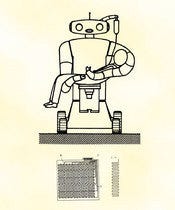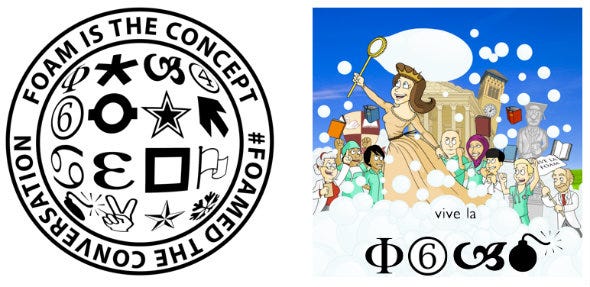Doctors Use Social For Continuous Medical EducationDoctors Use Social For Continuous Medical Education
By rebranding what they do on blogs and Twitter, advocates of Free Open Access Medical Education, or #FOAMed, seek to accelerate medical knowledge sharing.


Healthcare Robotics: Patently Incredible Inventions
Healthcare Robotics: Patently Incredible Inventions(click image for larger view and for slideshow)
There are serious medical conversations going on every day on Twitter, squeezed in between the celebrity news and the millions posting what they had for lunch. To find them, just search for #FOAMed.
The hashtag refers to the concept of Free Open Access Meducation (medical education), or FOAM, first promoted at the 2012 International Conference on Emergency Medicine in a lecture by Mike Cadogan, an emergency medicine physician, educator and digital media enthusiast from Australia. Frustrated by the resistance of many physicians and medical educators to the serious potential of social media, he decided to rebrand what he and others were doing online as a form of continuing education.
"I'd always seen blogging and podcasting as an amazing medium to use for medical education," Cadogan said in a Skype interview. He saw the rebranding as a way to "get people on board with something they felt was very beneath them."
The past year has seen proliferating use of the hashtag and specialty-specific variants on it (such as #FOAMcc for critical care doctors). While the Twitter feed itself, with its 140-character limit, doesn't lend itself to in deep exploration, it's acting as a carrier wave for broader conversations a click away in blogs, podcasts, videos and video chats. While this information has not gone through the same peer review filters as an article in a medical journal, enthusiasts say it is often more current and useful -- not necessarily for major research findings but as a way to share practical tips on techniques for the everyday practice of medicine.
[ Trend: Medical Practices Move Health IT To Cloud.]
"We've actively managed to engage a large group of researchers and significant academics who are moving away from writing textbooks and journal articles to doing more in the online arena," Cadogan said. "That's lending a sense of credence to what we're doing."
"The journals are still an essential part of the culture we work in," he allowed, but medical education is starting to be influenced by the open source and open content trends on the Internet, where "you take all the simple stuff, all the basic knowledge, and make it free." As an author of medical textbooks himself, Cadogan has decided it is more productive for him to spend his time blogging than to produce a new edition of one of those books.
Textbooks tend to be "outdated and expensive," whereas information gleaned from blogs and wikis can be better for fostering a "lifelong learning habit," said Michelle Lin, an associate professor of clinical emergency medicine at the University of California San Francisco and a contributor to the Academic Life in Emergency Medicine blog. Many FOAM enthusiasts will start a blog and use links posted to Twitter as "a means of directing people to their grander thoughts." Because of the growing number of clinical experts participating on Twitter, it can also be a powerful research tool, she said.
FOAM is distinct from the uses of social media for marketing or patient communication. Instead, the focus is on peer-to-peer networking of doctors.
Considered as education, FOAM mirrors what has been going on in other sectors of higher education with open educational resources (OERs) such as free digital textbooks and massive open online courses (MOOCs). At the undergraduate level, OER textbooks and other course materials are often promoted as a tool for lowering the cost of education, but also as a way of keeping instructional videos up to date by making them modular and digital. Although healthcare has some open textbook type projects of its own -- such as WikEM for emergency medicine -- most of the open education momentum is taking place outside of medical school.

FOAMed logo
While medical blogging and online activity is not new, it has a new focus.
"Really in the last year, it has just sort of exploded," said Haney Mallemat, an assistant professor and member of the department of emergency medicine at the University of Maryland School of Medicine. While medical blogging is not new, the hashtag is useful because doctors use it exclusively for subjects related to medical education, as "a sacred temple" where personal tweets or even discussions of healthcare politics should not intrude, he said. Longer term, he sees potential for the conversation to migrate to Google+, which supports longer posts and other useful features like video Hangouts.
Many of the participating doctors have taken to posting a daily "pearl" (as in, pearl of wisdom), a practice Mallemat has adopted. "Often I'll send out a picture of an X-ray and all I'll say is 'What is the diagnosis?' and later answer with bullet points. In that sense, it is pure education." Social networking among physicians is also an extension of what they do at conferences, where the focus is on "going beyond the textbook" to interacting directly with experts -- but now they can do it all year long, any hour of the day. In yet other cases, Mallemat may encounter a clinical problem he doesn't know how to solve, share it with his network (without patient identifiers), and "instantaneously get responses from around the globe."
"Is that classical medical education? Maybe not, but it's a new way of learning," Mallemat said.
"It's education in the broadest possible sense -- idea dissemination and discussion," said Ryan Patrick Radecki, an assistant professor at the University of Texas Medical School, whose specialties include emergency medicine and informatics. As an educational resource, FOAM materials may be particularly useful to physicians around the world whose hospitals may not have the budget to subscribe to all the relevant journals, he said.
Partly because it was first promoted at an emergency medical conference by an emergency medical physician, FOAM's center of gravity is very much in emergency medicine, although Cadogan said he also sees it taking off among general practitioners, pediatricians and others. Urology and cancer physicians are also starting to pay attention. One reason emergency physicians have a strong interest might have to do with their "short attention span and need to have answers quickly, with a large number of topics covered." An emergency room doctor needs to understand a little of all specialties, never knowing who might come in the door, he said. "They're also willing to discuss things far more openly and far more open to being wrong" and accepting new evidence that there is a better way to do something, he said.
FOAM has just advanced to the point where practitioners are starting to ask more serious questions, such as who is to blame for medical errors inspired by unreliable information from an online source, Cadogan said. Yet information in professional journals can be just as unreliable, or even fraudulent, he said, and doctors need to hone their critical thinking skills for all the information they consume.
As a polymath who writes software code in addition to practicing medicine and teaching, Cadogan is working on a new website that would correlate the best medical information available in social media. His first cut at that problem was the Global Medical Education Project (GMEP) website. He is particularly interested in organizing medical images that can be used for teaching purposes. Medical privacy rules have complicated the process of obtaining images to write about, and procedures for obtaining proper consent from patients are just now being solidified, he said. A library of images obtained in keeping with the rules and available under Creative Commons licensing would help solve that problem, he said.
Meanwhile, he sees FOAM as an "initial foray into collaborative education." Some of the trends sweeping through the rest of higher education are starting to make their way into medical school, such as the concept of a "flipped classroom" where students view video lectures and do most of their studying online, shifting the emphasis in classroom time from lecturing to discussing the material. Even though this approach is not officially sanctioned by the medical schools where he teaches, probably 90 out of 100 students in the lecture hall will have studied in advance.
"Now it's not two minutes of question time at the end of the lecture -- they want 20 minutes lecture time -- and that change has become wildly apparent over last 12-18 months," Cadogan said. "If you're sitting in a lecture hall to learn, you're not doing it right anymore."
Follow David F. Carr on Twitter @davidfcarr or Google+. His book Social Collaboration For Dummies is scheduled for release in October 2013.
About the Author
You May Also Like






